10
Connection
6.5 Driver I/O circuit
Input signals circuit
Input signals of the driver are C-MOS inputs.
The signal state represents "ON: 0 to 0.5 V (L level)"
and "OFF: 4 to 5 V (H level)."
C
R
+5 V
10 kΩ
C-MOS
0 V
Pin No.
7, 8, 9
10, 11
3
GND
Output signals circuit
Output signals of the driver are transistor open-collector
outputs. The signal state represents a state of "ON:
Carrying current" or "OFF: Not carrying current" for the
internal photocoupler rather than the voltage level of
the signal.
Driver internal circuit
0 V
0 V
Pin No.
1, 2
3
GND
R∗
*
Recommended resistance value when a current limiting resistor
R is connected:
For 24 VDC: 2.7 k
Ω
to 4.7 k
Ω
(1 W)
For 5 VDC: 560
Ω
to 820
Ω
(0.25 W)
Note
•
Be sure to suppress a current owing to the output circuit at 10 mA or less.
Connect a current limiting resistor R externally if the current exceeds this specied value.
•
When a relay (inductive load) is connected, provide a control measure for
the y-back voltage against the relay by connecting a diode. Or use a relay
with built-in ywheel diode.
1, 2
in No.
Inductive load
Fly
6.6 Connecting external analog setting devices
The rotation speed can be set using an external potentiometer (sold separately) or external DC voltage.
Using an external potentiometer
Connect to the pin No.4 to No.6 of the CN2.
PAVR2-20K
(sold separately)
21
3
VH
VM
VL
I/O signal connecto
(CN2)
0 to 20 kΩ
Blue
Green
Yellow
6
5
4
Note
When a shielded cable is used for connection with the external potentiometer, connect shields to VL of the pin No.4
from near the I/O signal connector (CN2).

